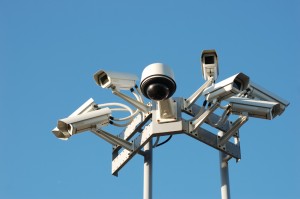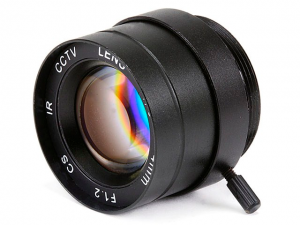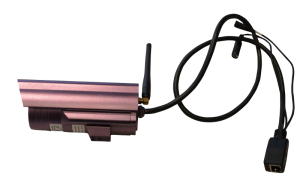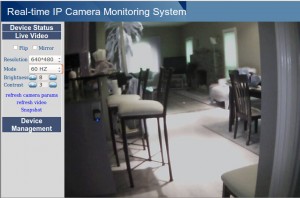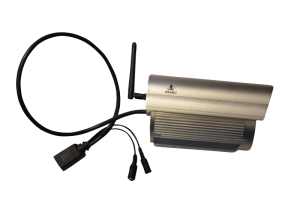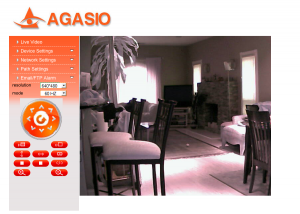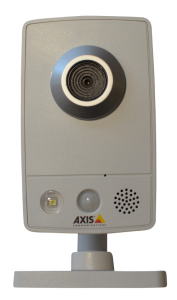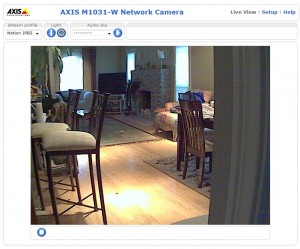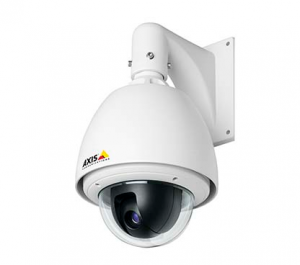There are a wide variety of IP (network) cameras available, ranging from the very inexpensive to the very good. That’s not to suggest that inexpensive cameras are not useful; it just means that you want to know which camera to use where.
If you just want to be able to see what’s happening on part of your farm, a cheap 640×480 (VGA size) camera will do a nice job. You can bring it up on your phone or tablet from anywhere on the farm, or port-forward to it to see what’s going on when you’re away. These cameras can be VERY inexpensive – from about $35 on Ebay – and they can work well for some applications; some are very small for indoor use, and some are built for outdoor use. The build quality on the very inexpensive ones is generally not great: one very inexpensive outdoor camera I purchased had the IC board held in place inside the housing with dabs of hot glue. That said, I still have it and it still works.
One thing to be aware of is that some inexpensive IP cameras require Internet Explorer to view the image on the camera. While this works with your laptop, it may keep you from seeing the camera on your phone or tablet (or they may offer a reduced-quality video stream for your phone or tablet), and it may prevent the camera from being integrated with a Network Video Recorder into an overall security system. If Internet Explorer is one of the requirements for the camera, I generally recommend against its use.
There are three major factors contributing to the quality of an IP camera:
1.) Image sensor – the size (1/4”, 1/3”, or larger) of the sensor and its resolution (640×480, 1024×720, 1280×960 or 1280×1024) – in general, the larger the better.
2.) Optics – good optics make a big difference. A full-HD (1280×1024) camera with a crummy lens is less useful than a VGA (640×480) camera with a sharp lens. Unfortunately, it is impossible to evaluate the quality of a lens from the specifications of the camera – the price of the camera is a reasonable, but not entirely reliable, proxy. Some cameras offer different “sizes” of lens – for instance, a 3.6 or even 2.8 mm wide-angle lens or a 6 or 8 mm telephoto lens. Obviously, what you are watching will determine what kind of lens you need.
3.) Firmware – the software running on the camera itself determines how easy it is to use and the features available. For instance, inexpensive cameras may offer MJPEG video streams and motion detection based on the entire scene the camera is surveying, while better cameras will offer h.264 streaming (which uses less bandwidth and better framerates – frames of video per second), and the ability to detect motion in specific zones of the camera’s picture.
The internal electronics and build quality of the camera make a difference, of course, but that is generally only an issue with the lowest-cost cameras – my own experience is that any name-brand camera costing more than $100 has adequate hardware and good build quality.
Here are three examples of IP cameras that I have purchased and evaluated, with specific comments on each.
1.) No-name $35 Outdoor WiFi Camera from Ebay (China). This little camera is actually one of my favorites. It has an adequate lens, a good, strong case, 640×480 resolution, and uses MJPEG for video. It sends about 4-5 frames per second, which is adequate for most purposes. It also has infrared (IR) LEDs in front for nighttime illumination. The biggest advantage this camera brings is that I can use it as a “scout” camera to see if I want to put a better camera in a particular place, and, if it gets kicked or dropped or destroyed, I won’t cry over it – I typically buy then 3 or 4 at a time and, if they have problems, I just throw them away.
2.) Agasio outdoor WiFi Camera. The specs on this camera are identical to the “no-name” camera above (WiFi, 640×480, MJPEG), but with more IR LEDs for better nighttime performance and a mechanical IR filter for better color in low light conditions. I am not actually sure the IR filter is that useful (and Foscam sells an identical camera without the IR filter), because it can fail in cold weather and make the picture look very odd as the filter clicks continuously in and out). I consider this (and the similar Foscam camera) the “workhorse” – it’s inexpensive and it works well, and Agasio/Foscam (they’re the same company) has an office in Houston you can call if you have trouble. I use these at my house to keep an eye on the yard, but I don’t use the motion detection capabilities because it’s very difficult to use effectively: if you turn the sensitivity down, you won’t capture motion when it happens, but, if you turn it up, you’ll be getting alarms every sunrise, sundown, and every time a cloud crosses the sun.
3.) Axis indoor WiFi camera M1031-W. Axis is generally acknowledged to be the highest-quality IP camera vendor, and appropriately priced. This is their lowest-cost unit, but it clearly shows the difference between their quality standards and those of the lower-cost cameras. Even though this camera has only a 640×480 sensor and a tiny lens, the picture is excellent and the firmware is very easy to use yet feature-filled. It offers several different kinds of streaming (MJPEG, h.264) and the ability to detect motion in “zones” you can select with a little Java applet on the camera. I use these cameras to protect my house, although I do get false alarms from it.
That’s a quick overview of the “cheap and the good” of the IP camera world. If you are just looking to have a camera on your farm that will allow you to see some critical item when you need to, I generally recommend one of the Foscam WiFi or Ethernet cameras. For more critical tasks, such as keeping an eye on a foaling mare, I generally recommend an appropriate Axis camera.
One handy thing you can do is have a camera way up on a pole or tower that you can swivel around and zoom in in any part of the farm. The Axis outdoor Point-Tilt-Zoom cameras can give you an amazing view of your property, but you’ll need to connect them to your network with an Ethernet cable (or an AyrMesh Hub, Receiver, or Bridge), because they don’t have WiFi. You’ll also need to mount them to something secure, because movement in the camera will make the quality of the picture moot.
Next, we’ll look at putting together a system of cameras for home and farm security, including cameras and Network Video Recorders – see part 3 here.

